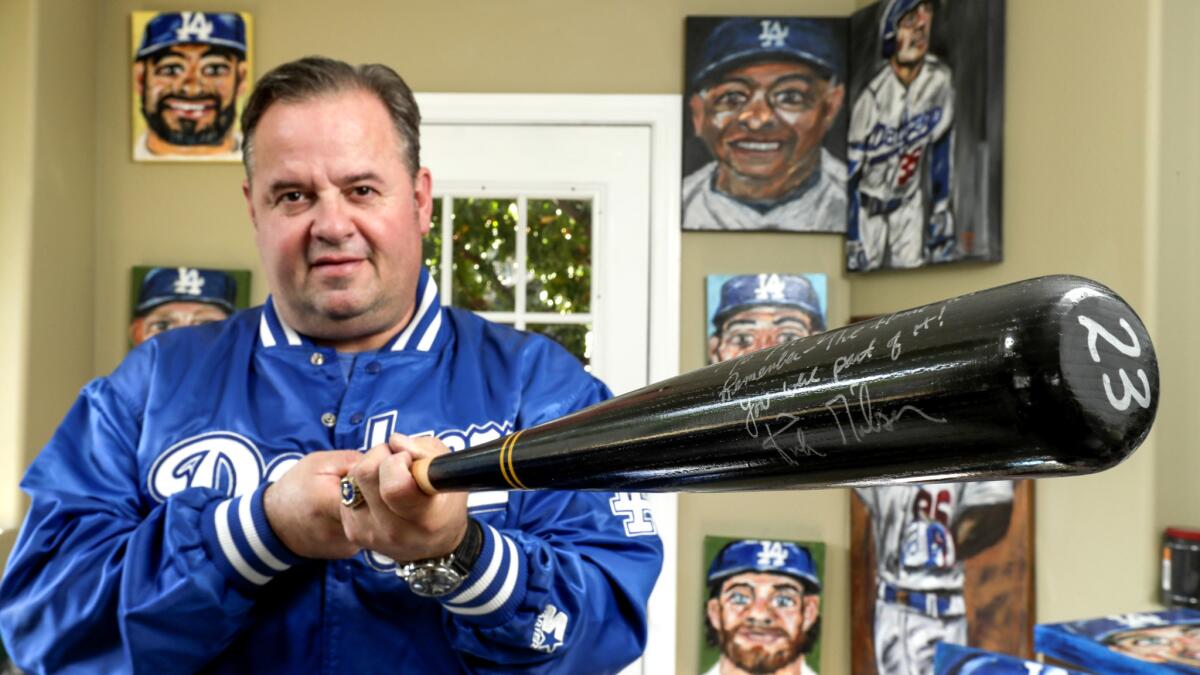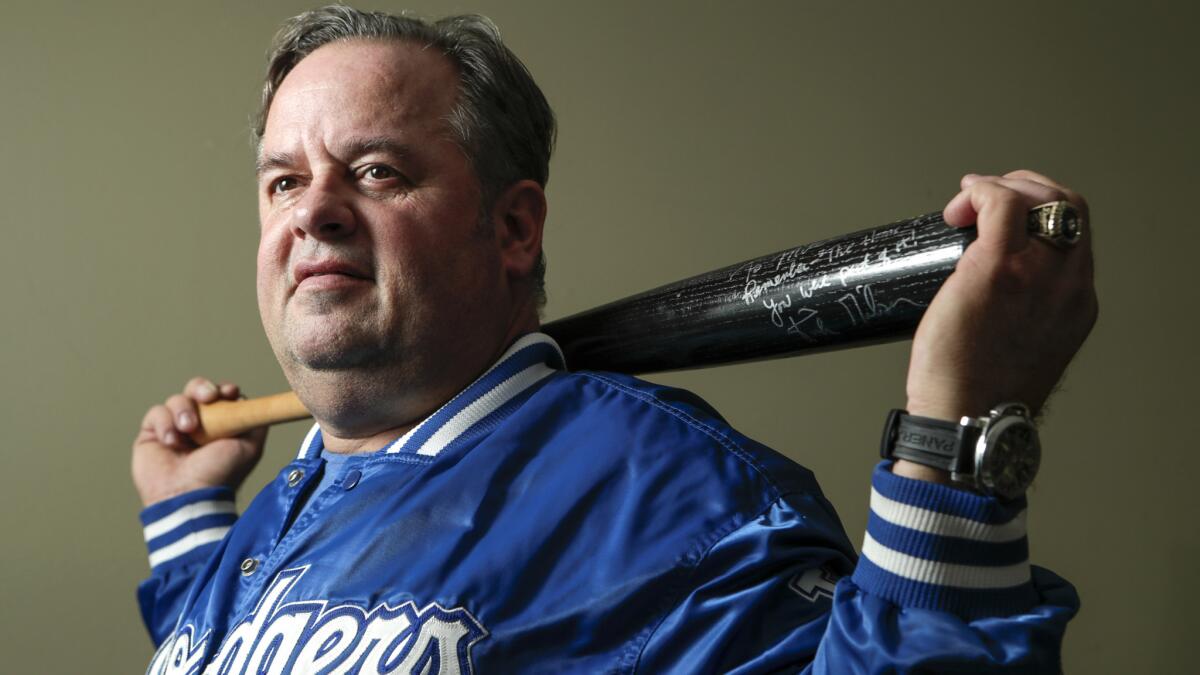Column: Before Gibson’s famous homer, he had to swing along with Mitch

- Share via
You’ve marveled at the swing, laughed at the brake lights, cheered with the fist pumps.
During the 28 years the Dodgers were absent from the World Series, you think you have watched every second of the greatest moment from the last time they were here, from the video of Kirk Gibson’s 1988 walk-off home run that inspired a championship.
The play has been viewed more than two million times on YouTube. The call from Vin Scully has been committed to memory. The photograph of Tom Lasorda running out of the dugout with his arms raised has been framed and immortalized.
You think you’ve seen all of it.
But now that they’re finally back in the World Series beginning Tuesday night at Dodger Stadium, there is something else you should know before your vision moves beyond the most enduring sports play in this city’s history.
You never saw the batboy.
With the 2017 Dodgers marching deep into October on the backs of unsung heroes, we should remember they are following a shadowed legend both “improbable’’ and “impossible.’’
His name is Mitch Poole. He was a 24-year-old kid who worked the Dodgers clubhouse, installed air conditioners on the side, and, for one hidden yet glorious moment, helped create a World Series legacy.
It is a tale so compelling that Gibson picked up the phone in Scotland on Saturday to talk about it.
“I’m laying on the trainer’s table, and Vin Scully is on TV saying I wasn’t going to play, so I jump up and shout, ‘My ass!’’’ recalled Gibson. “Then I look over and there’s Mitch.’’
::
Some days, he carried bats. Other days, he played catch with the outfielders. Most days, he washed jocks and hung jerseys and cleaned toilets.
Mitch Poole’s job as a Dodgers batboy in 1988 paid $25 a day for long hours with little recognition. The San Gabriel native and former Pasadena City College pitcher was content to be around the game he loved.
Then Gibson showed up. The notoriously cranky, competitive outfielder joined the team that winter as a free agent, and quickly made one thing clear: He cared nothing about status or job description. He judged people only on how hard they worked and how much they cared. He connected with Poole.
Said Gibson: “Mitch was always there for me. We developed a bond.’’
Said Poole: “All those days playing catch in the outfield, all the time doing things for him in the clubhouse, we became close.’’
When Gibson wanted to play a food prank on Tommy Lasorda — a common occurrence — Poole served as co-conspirator. Shortly before a game, Poole went into the stands and purchased a hamburger and brought it to Gibson, who opened it up and slathered both buns with pine tar. Poole then placed the burger on a water cooler outside the manager’s office, where Lasorda would see it and impulsively eat it.
Sure enough, that’s what happened, Lasorda checked to see if anyone claimed the burger, then picked it up and took a huge bite out of it before returning to his office. When the two pranksters realized what had happened, they panicked.
“Oh my God Mitch, we just killed him!’’ Gibson whispered to Poole.
Lasorda never said a word.
“Gibby was this big-time player, yet he was also just great to hang out with,’’ Poole said.
And, on the evening of Oct. 15, 1988, when Gibson needed him most, Poole was there.
It was Game 1 of the World Series against the heavily favored Oakland Athletics. Gibson, the Dodgers’ best player, was suffering from injuries to both legs, and not expected to play.
It was late in the game and the Dodgers were trailing, 4-3. Gibson had both knees encased in ice as television told the world he was not available.
Poole’s assignment that game was to stay in the clubhouse and wash uniforms. Protocol dictated he could not step on the field. He was picking up dirty towels in the training room when Gibson spotted him and enlisted him in a journey that would end in history.
“Mitch, get my uniform!’’ Gibson barked.
Poole hustled into the clubhouse and grabbed Gibson’s No. 23. Moments later, Gibson was dressed and holding a bat and looking for more help. He needed to take some swings in the underground batting cage. He needed someone to set the ball on a tee, and then later to toss him pitches.
Ben Hines, the Dodgers batting coach, walked up the runway to the field. Gibson asked Hines to pitch to him, but the coach said he was needed in the dugout.
“Get Mitch to do it,’’ Hines said.
Gibson was puzzled. The batboy? He had never helped anyone take batting practice in his life. Really? Mitch?
“Gibby looked at me funny, kind of shrugged and said, ‘OK, Mitch, let’s get to work,’’’ Poole recalled. “Looking back, I really believe I was placed there by God.’’
Gibson wanted the tee moved to where A’s pitcher Dennis Eckersley might be throwing back-door sliders. Poole figured out the right spot. Gibson strained with every hack.
“He was grunting and wincing with every swing, he was in so much pain,’’ Poole said. “I thought, ‘How is this guy going to do this?’’’
Poole then began tossing balls and, again, Gibson wanted them in a spot where Eckersley might pitch him. Poole made the adjustment and kept tossing, the swings becoming more fluid until the slugger suddenly turned to him.
“Mitch, this could be the script,’’ he said.
Years later, Poole still can’t believe what he heard. “I still get goose bumps just talking about it,’’ he said.
When Gibson was ready, he still didn’t want to show his face in the dugout, fearing the A’s would see him. He needed a messenger to Lasorda. It was the ninth inning, and he needed it done quickly.
“This was a World Series game and Mitch was a low-level guy and I knew it might be real uncomfortable for him to go out there and talk to the manager, but we didn’t have a choice,’’ Gibson said. “Mitch had to do it.’’
Creeping to the dugout corner where he hopefully wouldn’t be noticed by television cameras or the A’s, Poole shouted down the bench at Lasorda, who blew him off.
“You could hear Tommy saying something like, ‘I’m trying to manage a game, kid, leave me alone!’’’ Gibson recalled.
Poole shouted again, and this time an irritated Lasorda walked down to check on the commotion, at which point Poole elucidated from the bottom of his batboy lungs.
“Tommy!’’ he shouted. “Gibby says he can hit!’’
The rest is history. Gibson hit a two-out, two-run home run to give the Dodgers a 5-4 victory that ignited a run to the World Series championship in five games.
You don’t see Poole on the field during the celebration, because he didn’t want to violate protocol. Hines gave Poole credit during postgame interviews, but that credit has largely been forgotten. Because he was a part-time employee, Poole didn’t initially even get a championship ring. He has one now only because he was allowed to buy one.
One person who consistently honors the moment is Gibson, who still talks about it in reverent tones as an example of the power of the 1988 Dodgers.
“That was our team, everybody working so hard, nobody caring who got the credit, everybody contributing, from Mitch to the players to the front office, our internal organs were so strong,’’ Gibson said. “What happened with me and Mitch, that’s what happened all season with our entire team.’’
Gibson, a part-time Detroit Tigers TV analyst who now inspires in his fight against Parkinson’s Disease — he was diagnosed two years ago — is keeping that same selfless mantra with the current Dodgers World Series team.
He won’t be attending any of the games because he doesn’t want to be a distraction. “I don’t think it’s my place,’’ he said. “This is their moment, let them do their thing, this is about them.’’
He’s watching, though. He even sent a text message to Justin Turner when, on the 29th anniversary of Gibson’s blast, Turner dramatically hit the first Dodgers postseason walk-off homer since then in a National League Championship Series victory over the Chicago Cubs.
“It was such a cool deal, I had to text him, told him he’s worked hard, he’s earned it, a class act, a real pro,’’ Gibson said. “You know, you never forget that feeling. Every time I walk into Dodger Stadium, I look up to right field, where my ball landed, and I think of that moment. I’m just glad somebody else can have that feeling as well.’’
His advice for the current Dodgers: “They’re in a good spot, they’ve done such a great job in dealing with everything … but now they gotta finish it.’’
Which brings us back to Mitch Poole.
After the 1988 season, Poole was promoted to assistant clubhouse manager, and eventually became clubhouse manager for 15 years. He is now the visiting clubhouse manager while finishing his 32nd year in the organization.
Five years ago, the Dodgers held a bobblehead night for Gibson when he returned as manager of the Arizona Diamondbacks. He was scheduled to throw out the first pitch, but he stayed in the dugout, instead sending out a replacement dressed in a Dodgers polo shirt and khaki shorts.
It was Mitch Poole.


Get more of Bill Plaschke’s work and follow him on Twitter @BillPlaschke
ALSO:
The Dodgers’ road to the World Series: highlights from the NLCS
Column: Adrian Gonzalez chooses not to join Dodgers for this World Series
Scioscia says ’88 World Series team was special — and so are these Dodgers
More to Read
Go beyond the scoreboard
Get the latest on L.A.'s teams in the daily Sports Report newsletter.
You may occasionally receive promotional content from the Los Angeles Times.











